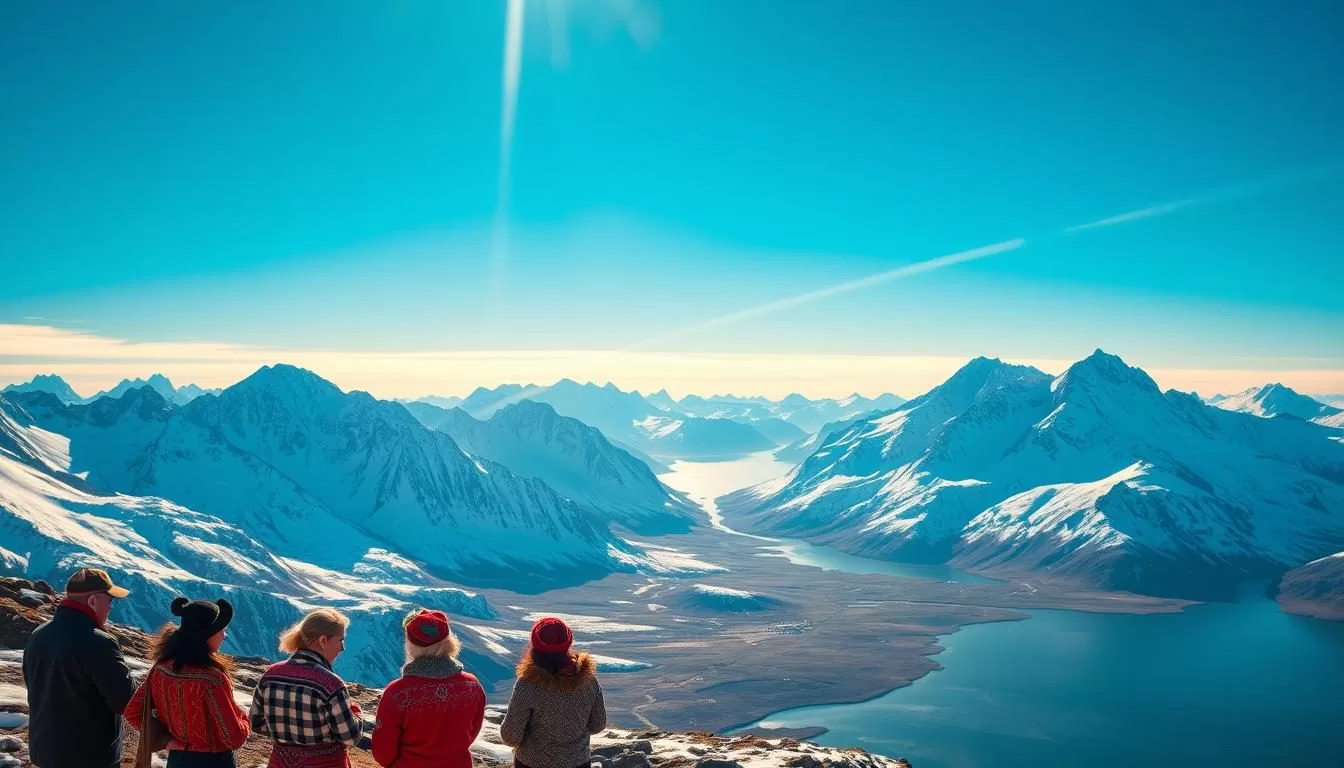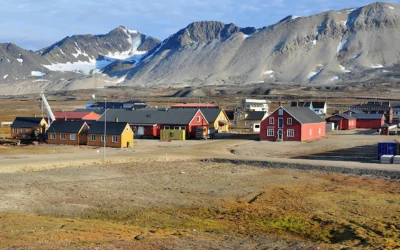✓ Accommodations ✓ Flights ✓ Rental Cars
Have you ever wondered how language shapes the identity of remote islands? In the Arctic, two unique territories stand out: Svalbard and Jan Mayen. These places are not just known for their stunning landscapes but also for their fascinating linguistic diversity.
Norwegian is the official language here, reflecting their ties to Norway. However, in settlements like Barentsburg, Russian is also widely spoken by a significant portion of the population. This blend of languages adds a unique cultural layer to these islands.
Exploring these linguistic facts reveals how language influences daily life and cultural integration in this Arctic setting. Stay tuned to learn more about the role of language in shaping the identity of these remarkable places.
Geographic Context and Natural Landscape
Discover the breathtaking Arctic landscape that defines these remote islands. Located halfway between mainland Norway and the North Pole, this archipelago is a stunning blend of icy fjords and rugged mountains. Its position in the Arctic Ocean shapes its unique environment, making it a fascinating region to explore.
The islands are known for their dramatic natural features. Vast areas are covered in ice, with glaciers and permafrost dominating the terrain. Fjords carve through the landscape, creating a mix of beauty and harshness that defines this Arctic zone.
Location and Arctic Setting
This archipelago lies in the heart of the Arctic Ocean, far from the mainland. Its remote location contributes to its unique climate and weather patterns. The region experiences long winters and short summers, with temperatures often staying below freezing.
Climate, Ice, and Fjord Formations
The climate here is shaped by its Arctic setting. Ice covers much of the area, with glaciers spanning thousands of square kilometers. Fjords, like Wijdefjorden and Isfjorden, are prominent features, adding to the island‘s dramatic scenery. These natural formations play a key role in shaping life and activities in this remote region.
Historical Background and Establishment
Centuries ago, explorers set foot on these lands, shaping their destiny. The 16th century marked the beginning of recorded history here, with Dutch explorer Willem Barentsz leading the way. His voyages opened the door to further exploration and discovery.
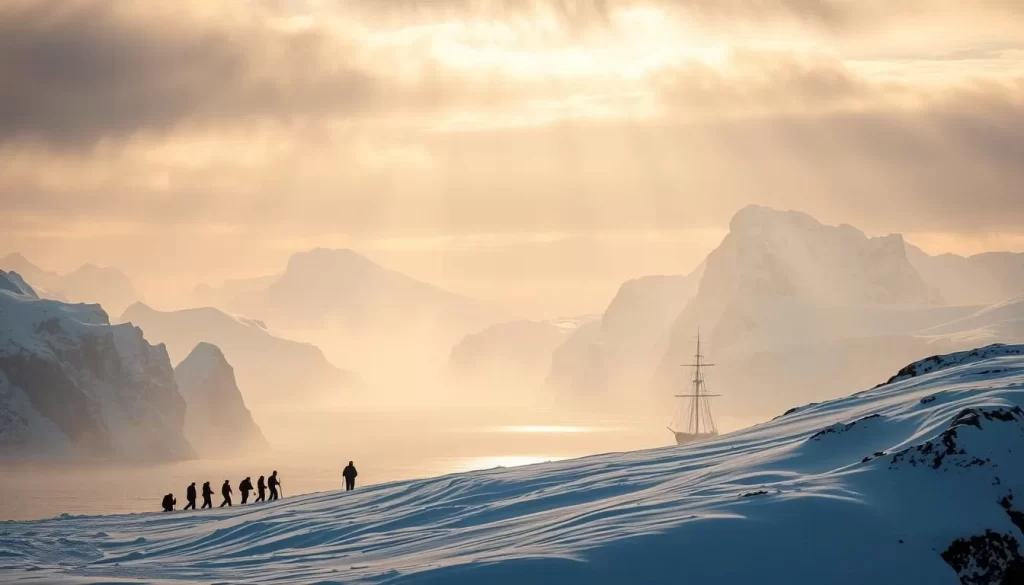
Whaling became a significant activity in the 17th century. Groups from various nations competed for resources, leading to a rise in economic activity. Over time, the decline of whaling shifted the focus to other industries.
Early Exploration and Whaling Beginnings
The early explorers faced harsh conditions, but their efforts laid the foundation for future settlements. Whaling attracted people from different countries, creating a diverse group of settlers. This period was crucial in shaping the islands’ identity.
Sovereignty and Political Evolution
Debates over sovereignty began in the early 20th century. Multiple nations claimed rights to these lands, leading to political disputes. Eventually, Norway gained control, solidifying its status as the governing country.
These historical facts provide context for the islands’ cultural and linguistic evolution. Understanding the past helps explain the present status of these unique territories.
Svalbard and Jan Mayen: Official and widely spoken languages
What role does language play in shaping the identity of remote Arctic territories? In these islands, Norwegian stands as the primary official language, reflecting their strong ties to Norway. This linguistic choice is deeply rooted in history and governance.
However, the linguistic landscape isn’t uniform. In settlements like Barentsburg, Russian is also widely spoken by a significant portion of the resident population. This blend of languages adds a unique cultural layer to the region.
Signage and local media, such as the Svalbardposten weekly, reflect this duality. Norwegian dominates, but Russian influences are visible in specific areas. This mix highlights the islands’ unique administrative status and cultural diversity.
Understanding these linguistic facts offers a doorway into the islands’ cultural richness. It shows how language shapes daily life and fosters integration in this remote Arctic setting.
Cultural and Demographic Insights
The Arctic islands are home to a unique blend of cultures and people. Despite their remote location, these territories boast a small but diverse population. This mix of residents adds a rich cultural layer to the region.

Longyearbyen, the largest settlement, serves as the cultural hub. Here, you’ll find a mix of Norwegian and non-Norwegian persons. This diversity is reflected in the city’s infrastructure and daily life.
Population Diversity and Settlement Patterns
The population of these islands is concentrated in a few key areas. Longyearbyen is the most prominent, with smaller settlements like Barentsburg also playing a role. Each settlement has its own distinct character and cultural influences.
In Longyearbyen, the city’s infrastructure supports a vibrant community. Schools, shops, and cultural events cater to both Norwegian and international residents. Smaller settlements, however, often have fewer amenities but retain their unique charm.
| Settlement | Population | Primary Language |
|---|---|---|
| Longyearbyen | 2,400 | Norwegian |
| Barentsburg | 500 | Russian |
| Ny-Ålesund | 35 | Norwegian |
This demographic mix influences the islands’ cultural and linguistic dynamics. The blend of Norwegian and non-Norwegian persons creates a unique environment. It’s a testament to the islands’ ability to adapt and thrive in a remote country.
Language Dynamics in the Arctic Region
The Arctic region is a fascinating study in how language evolves in extreme environments. Here, Norwegian stands as the dominant language, reflecting the region’s strong ties to Norway. This linguistic dominance is deeply rooted in history and governance, shaping daily life and cultural identity.
Norwegian Language Dominance and Variants
Norwegian is the primary language spoken across the Arctic. Two main variants, Bokmål and Nynorsk, are used in different contexts. Bokmål is more common in urban areas, while Nynorsk is often found in rural settings. This duality reflects the nation’s efforts to preserve linguistic diversity.
Over time, these variants have adapted to the unique needs of Arctic communities. For example, local dialects often incorporate words from indigenous languages or other influences. This blending creates a rich linguistic tapestry that continues to evolve.
Linguistic Nuances in Local Communities
In smaller settlements, linguistic nuances emerge from multicultural influences. While Norwegian remains the official language, other languages like Russian or English are also spoken. This mix is especially evident in areas with international research stations or tourism hubs.
Research plays a key role in understanding these dynamics. Studies highlight how daily communication and cultural exchange shape language use. These insights reveal the Arctic’s unique ability to adapt and thrive linguistically.
Understanding these facts offers a deeper appreciation of the region’s cultural richness. It shows how language connects people and fosters integration in this remote yet vibrant part of the world.
Soviet Influences on Language and Culture
The Arctic’s remote corners hold stories of cultural exchange that still echo today. In places like Barentsburg, the legacy of Soviet-era settlements is evident in the language and daily life. Russian remains widely spoken, a testament to the region’s historical ties to the Soviet Union.
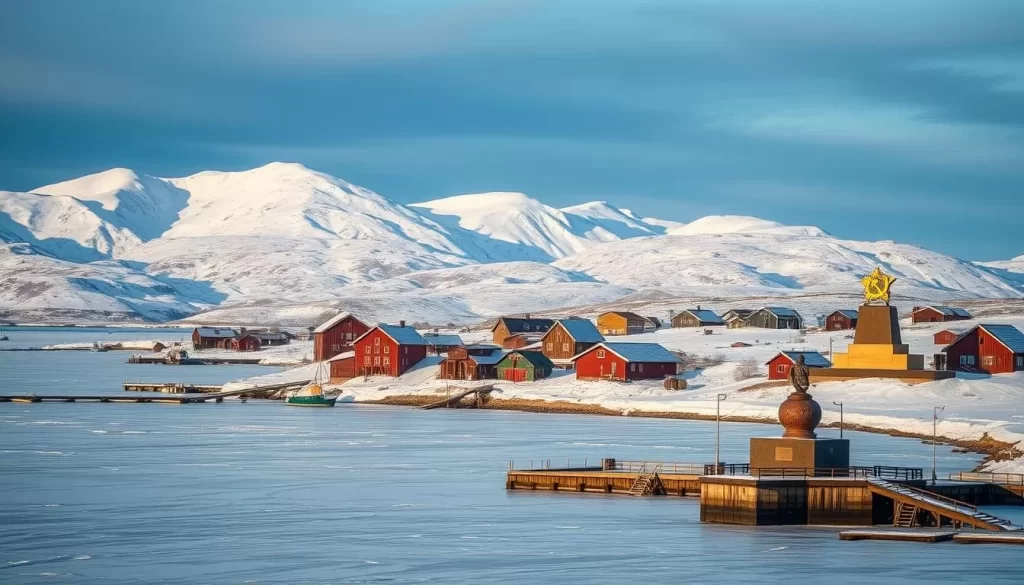
Military and research stations established during the Soviet era played a key role in shaping this linguistic landscape. These stations brought Russian-speaking workers and their families, embedding the language into the local culture. Today, signs in Russian alongside Norwegian reflect this unique blend.
Heritage and Russian Language Impact
The Russian language’s influence extends beyond words. It’s woven into the region’s heritage, from traditional songs to local customs. Even on isolated islands like Jan Mayen Island, traces of this era can be found in cultural artifacts and oral histories.
Despite the dominance of Norwegian, Russian elements coexist harmoniously. This duality is especially visible in areas with international research stations, where both languages are used daily. It’s a fascinating example of how cultures adapt and thrive in remote settings.
“The blending of Russian and Norwegian languages in the Arctic is a testament to the region’s rich history of cultural exchange.”
For more insights into how these influences shaped the region, explore the cultural exchange in Svalbard. This resource delves deeper into the historical and cultural dynamics that continue to define these unique territories.
Economic Activities Shaping Linguistic Interaction
Economic activities in remote regions often shape the way people communicate. In these Arctic territories, industries like coal mining and tourism play a significant role in influencing daily language use. These sectors bring together diverse groups, creating a unique linguistic environment.
Coal Mining, Tourism, and Day-to-Day Language Use
Coal mining has long been a cornerstone of the local economy. Workers in this industry often use specialized terms related to mining operations. This vocabulary becomes part of everyday conversations, especially in communities where mining is a primary activity.
However, the decline in coal mining has shifted focus to other sectors. Tourism, particularly cruise tourism, has grown significantly. This influx of visitors introduces new words and phrases, enriching the local dialects. Service workers often learn multiple languages to cater to international guests.
Here’s how economic activities influence language:
- Mining introduces technical terms into daily speech.
- Tourism brings in foreign words and phrases.
- The service sector encourages multilingual communication.
Financial transactions also play a role. The use of currency and trade terms adds another layer to the linguistic landscape. This blend of economic activities creates a dynamic and evolving language environment.
For example, in Jan Mayen’s economic activities, the focus on research and meteorological services has introduced scientific terminology into local conversations. This shows how diverse industries shape communication in unique ways.
Understanding these interactions offers insight into how economic activities drive linguistic diversity. It highlights the adaptability of language in response to changing economic landscapes.
Modern Research and Multilingual Presence
Modern research in remote Arctic regions has sparked a unique blend of linguistic diversity. International collaboration in these areas has turned research stations into hubs for scientific innovation and cultural exchange. These stations attract experts from around the world, creating a dynamic environment where multiple languages thrive.
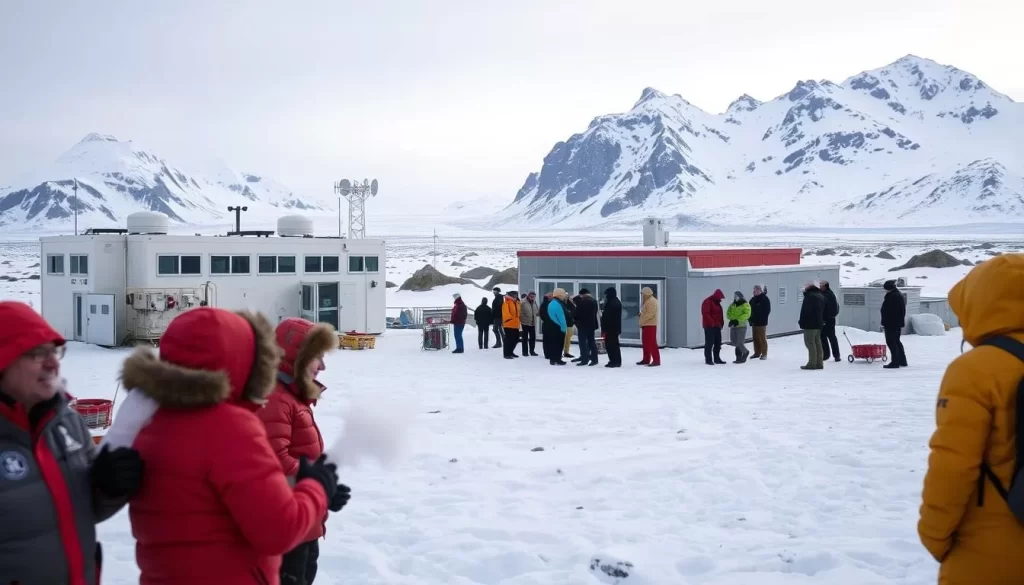
Research Stations and International Collaboration
Research stations like Ny-Ålesund serve as centers for global scientific efforts. Teams from various countries work together, bringing their native languages into daily interactions. This multilingual presence enhances communication and fosters a sense of global unity.
Over time, these stations have adapted to accommodate diverse linguistic needs. For example, meetings and publications often use English as a common language, while local dialects and other languages are respected and integrated.
Emerging Trends in Language Use
Emerging trends show a shift toward multilingualism in academic and research settings. The use of multiple languages is no longer a barrier but a bridge to deeper collaboration. This trend is supported by advancements in technology, which facilitate real-time translation and communication.
Here’s a breakdown of key facts about language use in Arctic research stations:
| Language | Percentage of Use | Primary Context |
|---|---|---|
| English | 65% | Meetings, Publications |
| Norwegian | 20% | Local Interactions |
| Russian | 10% | Collaborative Projects |
| Other | 5% | Specialized Research |
These trends highlight the importance of multilingualism in fostering global cooperation. For more insights, explore this guide on multilingual content marketing.
Understanding these dynamics offers a glimpse into the future of communication in remote research hubs. It’s a testament to how language connects people and drives innovation in the most isolated corners of the world.
Travel and Practical Information for Visitors
Planning a trip to these Arctic islands? Here’s what you need to know. From visa-free entry to currency tips, this guide ensures your visit is smooth and enjoyable. Let’s dive into the essentials for travelers.
Visa-Free Entry and Currency Tips
One of the best perks for visitors is the visa-free policy. As part of Norway, these islands allow entry without a visa for most travelers. However, you’ll still need a valid passport and proof of onward travel. This makes it easier to explore the region without lengthy paperwork.
When it comes to currency, the Norwegian Krone (NOK) is the official tender. While credit cards are widely accepted, it’s wise to carry some cash for smaller transactions. ATMs are available in Longyearbyen, the capital city, but they may be limited in other areas.
Key Services in Longyearbyen
Longyearbyen is the main hub for travelers, offering essential services. The city has a well-equipped airport, making it the primary entry point for most visitors. Public transport is limited, so renting a snowmobile or joining guided tours is common.
For medical needs, the local hospital provides free treatment for Nordic residents. Others should ensure they have private insurance. Pharmacies are available, but it’s best to bring any necessary medications.
Here’s a quick overview of key services:
| Service | Details |
|---|---|
| Airport | Located in Longyearbyen, connects to mainland Norway |
| Hospital | Free for Nordic residents, private insurance required for others |
| ATMs | Available in Longyearbyen, limited elsewhere |
| Transport | Snowmobiles and guided tours recommended |
For more details on the Svalbard and Jan Mayen visa-free policy, check out this resource. It’s packed with useful information to help you plan your trip.
With these tips, you’re ready to explore these unique islands. Whether you’re here for tourism or research, the experience is sure to be unforgettable.
Conclusion
The Arctic islands are a unique blend of history, culture, and natural beauty. Norwegian is the primary language, reflecting strong ties to mainland Norway. Yet, the linguistic landscape is enriched by other influences, especially in areas like Barentsburg, where Russian is widely spoken.
These territories are home to a diverse population, with settlements like Longyearbyen serving as cultural hubs. The blend of languages and traditions creates a vibrant community in this remote region. Economic activities, from coal mining to tourism, further shape daily interactions and language use.
Historical events, such as the Svalbard Treaty, have played a key role in shaping the islands’ identity. This treaty ensures equal rights for all treaty parties, fostering a sense of global unity. Modern research stations also contribute to the multilingual presence, making these islands a fascinating study in cultural exchange.
To learn more about Norway’s linguistic diversity, visit this resource. It’s a testament to how language connects people in even the most remote parts of the world.
The above is subject to change.
Check back often to TRAVEL.COM for the latest travel tips and deals.
